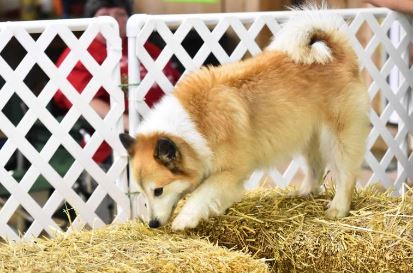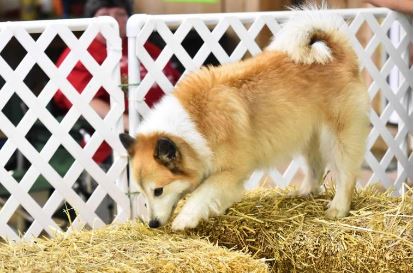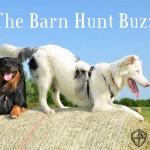Have You Herd About Barn Hunt?
Understanding, Training a Herding Breed Dog in Barn Hunt

So you want to Barn Hunt with your herding breed dog. What should you know about playing Barn Hunt with a herding breed? What makes them different than other groups? How do herding breeds fare in Barn Hunt? This article will discuss some common herding breed dog hunting styles, as well as what to expect when training and trialing your dog in Barn Hunt.
Herding Dogs Excel in Barn Hunt
 Overall, herding dogs are exceptionally strong in this sport. A herding breed won the BHA National Versatility Championship and 4 medals (out of 9) went to herding breeds with one medal being shared between two herding breed dogs. Herding dogs have the instinct, physical attributes and attitude to play this game. Dogs with strong hunting drive but also a willingness to be a team player are the dogs that excel in this sport. Sound like a herding dog? You bet!
Overall, herding dogs are exceptionally strong in this sport. A herding breed won the BHA National Versatility Championship and 4 medals (out of 9) went to herding breeds with one medal being shared between two herding breed dogs. Herding dogs have the instinct, physical attributes and attitude to play this game. Dogs with strong hunting drive but also a willingness to be a team player are the dogs that excel in this sport. Sound like a herding dog? You bet!
Herding dogs seem to enjoy games, especially hide and go seek games like tracking, scent work, and Barn Hunt. Many herding breeds have been selectively bred for being keen on scent for use in search and rescue, police work and tracking. Their fixation on finding helps them greatly in Barn Hunt.
Hunting… Herding Dog Style
Herding dog “hunting” or “finding” style is quite interesting. Some dogs are movement-oriented and get really excited when they see something “scurry, yet lose interest when movement stops. Others are driven to find critters by scent even if they can’t see them, and the drive to find the item may be greater than the drive to be rewarded with a treat or with a gentle wiggle of the tube.
Dogs that are strictly movement-oriented hunters (chasers) can offer unique challenges. They are looking for something to run or scurry before they give chase. They are triggered by movement. Movement is not something your dog will see in Barn Hunt! Dogs must use their nose to locate rats, which is why Barn Hunt is very similar to canine scent work and odor detection venues. This can be somewhat troublesome for a sight-motivated dog. For dogs that are motivated by movement, introductions should include rats in safety cages, clear tubes, or behind protective barriers like e-pens or thick mesh rat cages. The dog should never have access to a loose rat that is not in their container and closed up safely. It may take a few introductions before the dog understands they are not hunting with their eyes…but herding dogs learn fast!
cages. The dog should never have access to a loose rat that is not in their container and closed up safely. It may take a few introductions before the dog understands they are not hunting with their eyes…but herding dogs learn fast!
Herding dogs that hunt using scent are some of the easiest dogs to introduce to the game. These dogs can often be presented with a rat in a tube and they “get it”. Every once in awhile these dogs can get “tube euphoria” and lose their ability to discriminate between rat and litter/empty because they are so excited by just playing the game. There are training techniques to help this issue but time and experience are often what is needed to prevent an enthusiastic herding dog from hitting on the first tube they see!
Herding Dogs Can Be Different
As you move through your career in Barn Hunt with your herding dog, you may notice your handling or the environment affects your dog differently than other dogs, such as terriers and sporting dogs. You may see your fellow herding dog teams seem prone to specific issues, like leaving a “crowded space” or hitting on every tube they see. These are due in part to specific traits that herding dogs may have been selected for which helped them in their original role. Understanding it may help you to “fix” it.
 One of the largest differences I have seen in herding dogs is their reaction to space pressure. Dogs that have been on stock or are actively used as herding dogs are exceptionally aware of other organisms’ pressure. While working, they may not want to be in your space nor want you in their space. Your pressure on your dog may affect their behavior. Even if your dog has never even seen a sheep, it may be susceptible to these influences because it was bred for it.
One of the largest differences I have seen in herding dogs is their reaction to space pressure. Dogs that have been on stock or are actively used as herding dogs are exceptionally aware of other organisms’ pressure. While working, they may not want to be in your space nor want you in their space. Your pressure on your dog may affect their behavior. Even if your dog has never even seen a sheep, it may be susceptible to these influences because it was bred for it.
Herding dogs were selected for reaction to stock pressure and handler pressure. This can be seen in the methods used for training these dogs on the herding fields. In herding we may use stock pressure to push back on the dog or we use the dog’s pressure to keep access to a gate clear of sheep. A way to visualize this is an imaginary bubble/force field around you and the dog and the stock. The size and the strength of these bubbles are determined by the individual creature. When a strong bubble pushes on a weaker bubble - someone reacts to relieve the pressure. There is a redirection of movement or a reaction of some kind, like barking. This pressure concept can also be seen in Barn Hunt, but manifests itself a bit differently. For instance, herding dogs can be affected by how close their handlers are to them while they hunt. If a handler hovers over their dog, the handler’s pressure can inadvertently force the dog into a (indication) behavior OR can push the dog completely off a tube. Add in a very talkative and forcefully questioning handler and a dog may indicate to relieve the pressure. By filming and watching your runs you can see the effect your presence has on the dog. Handlers of herding dogs need to be aware of this effect, as do judges and rat wranglers.
 Another fun herding dog difference is full-tilt “Tube Euphoria”. “Tube Euphoria” is where EVERY tube has a rat in it, even if it actually doesn’t! Enthusiastic herding dogs are most prone to this. Herding dogs are certainly enthusiastic about life and their jobs, so it’s no wonder this issue comes up from time to time. Sometimes it’s due to a weak foundation in the differences between the tube types and sometimes it’s due to an over-emotional dog. Dogs that have not been allowed the time to compare and contrast rat versus empty or litter tubes cannot fully understand the difference. They need to know the goal is to find the RAT tubes. Showing the dog many combinations of litter, empty, and rat tubes, and then allowing the dog to compare can often help. Rewarding the dog on ONLY the correct tube, with food or a little gentle tube wiggle may be just the ticket. Other techniques include showing the dog lots of litter tubes and tubes of different “strength” litters.
Another fun herding dog difference is full-tilt “Tube Euphoria”. “Tube Euphoria” is where EVERY tube has a rat in it, even if it actually doesn’t! Enthusiastic herding dogs are most prone to this. Herding dogs are certainly enthusiastic about life and their jobs, so it’s no wonder this issue comes up from time to time. Sometimes it’s due to a weak foundation in the differences between the tube types and sometimes it’s due to an over-emotional dog. Dogs that have not been allowed the time to compare and contrast rat versus empty or litter tubes cannot fully understand the difference. They need to know the goal is to find the RAT tubes. Showing the dog many combinations of litter, empty, and rat tubes, and then allowing the dog to compare can often help. Rewarding the dog on ONLY the correct tube, with food or a little gentle tube wiggle may be just the ticket. Other techniques include showing the dog lots of litter tubes and tubes of different “strength” litters.
Lastly, another herding dog difference is over enthusiasm and emotion. Enthusiastic, overstimulated, or emotional dogs may need to take time-outs. During training, if you or the dog becomes emotional, you are no longer training and may be going backwards! An over-emotional, overstimulated dog is reacting and not thinking. A heavily panting dog that doesn’t appear to be thoroughly hunting but rather spinning, running on top of bales, or flitting from place to place is likely overstimulated. Stop, take a break, or have a “Zen” moment to allow everyone to get their composure back before starting again. This can be done during a trial as well. Stop, count to 5 or 10, and then start again. Understanding your dog and their emotional state will help you avoid future issues.
Clearly herding dogs have the formula for success in Barn Hunt and training will improve your experience and results. Understanding your dog and the effect you have on her will help greatly. If you have some challenges pop up along the way, film your runs and watch them with an eye on both you and your dog. You may notice that your body language or behavior are affecting your dog or that your dog is getting too worked up and needs some calming moments to get refocused. Training is out there for Barn Hunt and can really help you understand your herding dog.
Best of luck and happy hunting!
Article By:
Eva Raczka
Meet Our Evangelist







